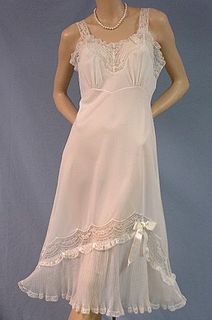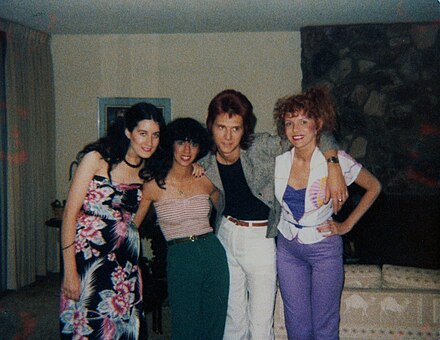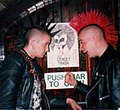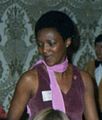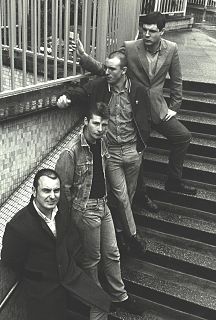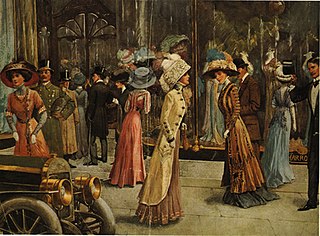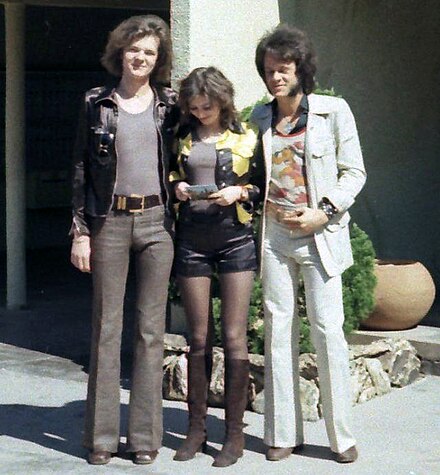

Fashion in the 1970s was about individuality. In the early 1970s, Vogue proclaimed "There are no rules in the fashion game now" [1] due to overproduction flooding the market with cheap synthetic clothing. Common items included mini skirts, bell-bottoms popularized by hippies, vintage clothing from the 1950s and earlier, and the androgynous glam rock and disco styles that introduced platform shoes, bright colors, glitter, and satin. [2]
Vogue is a fashion and lifestyle magazine covering many topics including fashion, beauty, culture, living, and runway. Vogue began as a weekly newspaper in 1892 in the United States, before becoming a monthly publication years later.
In economics, overproduction, oversupply, excess of supply or glut refers to excess of supply over demand of products being offered to the market. This leads to lower prices and/or unsold goods along with the possibility of unemployment.
Bell-bottoms are a style of trousers that become wider from the knees downward, forming a bell-like shape of the trouser leg.
Contents
- Women
- Early 1970s (1970–1973)
- Mid 1970s (1974–1976)
- Late 1970s (1977–1979)
- Men
- Early 1970s (1970–1973) 2
- Mid 1970s (1974–1976) 2
- Late 1970s (1977–1979) 2
- Teenage fashion
- Mods
- Teddy boys
- Hippies
- Heavy metal
- Black power
- Cholos
- Punks
- 1970s beauty trends
- Women's hairstyles
- Men's hairstyles
- Makeup and cosmetics
- Image gallery
- References
- External links
New technologies brought advances in production through mass production, higher efficiency, generating higher standards and uniformity. Generally the most famous silhouette of the mid and late 1970s for both genders was that of tight on top and loose on bottom. The 1970s also saw the birth of the indifferent, anti-conformist casual chic approach to fashion, which consisted of sweaters, T-shirts, jeans and sneakers. The French designer, Yves Saint Laurent and the American designer Halston both observed and embraced the changes that were happening in the society, especially the huge growth of women's rights and the youth counterculture. They successfully adapted their design aesthetics to accommodate the changes that the market was aiming for.
Yves Henri Donat Mathieu-Saint-Laurent, professionally known as Yves Saint-Laurent, was a French fashion designer who, in 1961, founded his eponymous fashion label. He is regarded as being among the foremost fashion designers in the twentieth century. In 1985, Caroline Rennolds Milbank wrote, "The most consistently celebrated and influential designer of the past twenty-five years, Yves Saint Laurent can be credited with both spurring the couture's rise from its 1960s ashes and with finally rendering ready-to-wear reputable." He was able to adapt his style to accommodate the changes in fashion during that period. He approached fashion in a different perspective by wanting women to look comfortable yet elegant at the same time. He is also credited with having introduced the tuxedo suit for women and was known for his use of non-European cultural references, and non-white models.

Roy Halston Frowick, known simply as Halston, was an American fashion designer who rose to international fame in the 1970s.

A counterculture is a subculture whose values and norms of behavior differ substantially from those of mainstream society, often in opposition to mainstream cultural mores. A countercultural movement expresses the ethos and aspirations of a specific population during a well-defined era. When oppositional forces reach critical mass, countercultures can trigger dramatic cultural changes. Prominent examples of countercultures in Europe and North America include Romanticism (1790–1840), Bohemianism (1850–1910), the more fragmentary counterculture of the Beat Generation (1944–1964), followed by the globalized counterculture of the 1960s (1964–1974), usually associated with the hippie subculture and the diversified punk subculture of the 1970s and 1980s.
The top fashion models of the 1970s were Lauren Hutton, Margaux Hemingway, Beverly Johnson, Gia Carangi, Janice Dickinson, Cheryl Tiegs, Jerry Hall, and Iman.
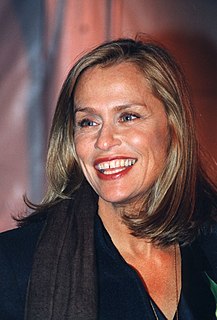
Mary Laurence "Lauren" Hutton is an American model and actress. Raised in the southern United States, Hutton relocated to New York City in her early adulthood to begin a modeling career. Though she was initially dismissed by agents for a signature gap in her teeth, Hutton signed a modeling contract with Revlon in 1973, which at the time was the biggest contract in the history of the modeling industry.

Margot Louise Hemingway, was an American fashion model and actress, known as Margaux Hemingway. The statuesque Hemingway earned success as a supermodel in the mid-1970s appearing on the covers of Cosmopolitan, Elle, Harper's Bazaar, Vogue, and TIME.

Beverly Ann Johnson is an American supermodel, actress, singer, and businesswoman. Johnson rose to fame when she became the first African-American model to appear on the cover of American Vogue in August 1974. In 1975, Johnson became the first black woman to appear on the cover of the French edition of Elle. In 2012, Johnson was the star of the reality series Beverly's Full House which aired on the Oprah Winfrey Network (OWN). The New York Times named Johnson one of the 20th century's most influential people in fashion in 2008.




